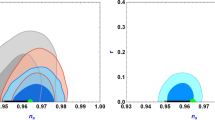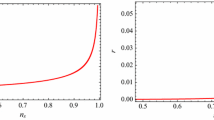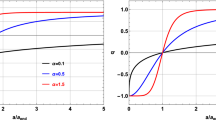Abstract
We consider a possible scenario for the evolution of the early cold Universe born from a fairly large quantum fluctuation in a vacuum with a size a 0 ≫ l P (where l P is the Planck length) and filled with both a nonlinear scalar field φ, whose potential energy density U(φ) determines the vacuum energy density λ, and a nonideal Fermi gas with short-range repulsion between particles, whose equation of state is characterized by the ratio of pressure P(n F ) to energy density ε(n F ) dependent on the number density of fermions n F . As the early Universe expands, the dimensionless quantity ν(n F ) = P(n F )/ε(n F ) decreases with decreasing n F from its maximum value νmax = 1 for n F → ∞ to zero for n F → 0. The interaction of the scalar and gravitational fields, which is characterized by a dimensionless constant ξ, is proportional to the scalar curvature of four-dimensional space R = κ[3P(n F )–ε(n F )–4λ] (where κ is Einstein’s gravitational constant), and contains terms both quadratic and linear in φ. As a result, the expanding early Universe reaches the point of first-order phase transition in a finite time interval at critical values of the scalar curvature R = R c =–μ2/ξ and radius a c ≫ a 0. Thereafter, the early closed Universe “rolls down” from the flat inflection point of the potential U(φ) to the zero potential minimum in a finite time. The release of the total potential energy of the scalar field in the entire volume of the expanding Universe as it “rolls down” must be accompanied by the production of a large number of massive particles and antiparticles of various kinds, whose annihilation plays the role of the Big Bang. We also discuss the fundamental nature of Newton’ gravitational constant G N .
Similar content being viewed by others
References
A. D. Linde, Phys. Lett. B 108, 389 (1982).
A. D. Linde, Phys. Lett. B 129, 177 (1983).
A. D. Linde, JETP Lett. 38, 176 (1983).
A. Linde, Particle Physics and Inflationary Cosmology, Contemporary Concepts in Physics, Vol. 5 (Harwood Academic, Chur, 1990; Nauka, Moscow, 1990).
P. W. Higgs, Phys. Lett. 12, 132 (1964).
P. W. Higgs, Phys. Rev. Lett. 13, 508 (1964).
E. A. Pashitskii and V. I. Pentegov, J. Exp. Theor. Phys. 122, 52 (2016).
L. D. Landau and E. M. Lifshitz, Course of Theoretical Physics, Vol. 5: Statistical Physics (Fizmatlit, Moscow, 2002; Pergamon, Oxford, 1980).
Ya. B. Zel’dovich, Sov. Phys. JETP 14, 1143 (1961).
L. Kofman, A. Linde, and A. A. Starobinsky, Phys. Rev. D 56, 3258 (1997).
G. Gamov, Phys. Rev. 70, 572 (1946).
J. Schwinger, Particles, Sources, and Fields (Westview, New York, 1998; Mir, Moscow, 1973).
S. Weinberg, The Quantum Theory of Fields (Cambridge Univ., Cambridge, 2000; Fizmatlit, Moscow, 2003).
I. V. Krive, A. D. Linde, and E. M. Chudnovskii, Sov. Phys. JETP 44, 435 (1976).
A. Linde, Phys. Rev. D 49, 748 (1994).
F. L. Bezrukov and M. E. Shaposhnikov, Phys. Lett. B 659, 703 (2008).
F. Englert and R. Brout, Phys. Rev. Lett. 13, 321 (1964).
G. S. Guralnik, C. R. Hagen, and T. W. B. Kibble, Phys. Rev. Lett. 13, 585 (1964).
D. A. Kirzhnits, JETP Lett. 15, 529 (1972).
D. A. Kirzhnits and A. D. Linde, Sov. Phys. JETP 40, 628 (1974).
J. Maldacena, Adv. Theor. Mat. Phys. 2, 331 (1980).
O. Aharoni, S. Gubser, J. Maldacena, et al., Phys. Rep. 323, 183 (2000).
O. Aharoni, O. Bergman, D. L. Jafferis, et al., High Energy Phys. 10, 91 (2008).
A. Einstein, Sitzungber. Preuss. Akad. Wiss. 1, 688 (1916).
B. P. Abbott, R. Abbott, T. D. Abbott, et al., Phys. Rev. Lett. 116, 061102 (2016).
S. H. Dong, Wave Equations in Higher Dimensions (Springer, Berlin, 2011).
Author information
Authors and Affiliations
Corresponding author
Additional information
Original Russian Text © E.A. Pashitskii, V.I. Pentegov, 2017, published in Zhurnal Eksperimental’noi i Teoreticheskoi Fiziki, 2017, Vol. 151, No. 3, pp. 508–522.
Rights and permissions
About this article
Cite this article
Pashitskii, E.A., Pentegov, V.I. Inflation of the early cold Universe filled with a nonlinear scalar field and a nonideal relativistic Fermi gas. J. Exp. Theor. Phys. 124, 433–445 (2017). https://doi.org/10.1134/S1063776117020078
Received:
Published:
Issue Date:
DOI: https://doi.org/10.1134/S1063776117020078




